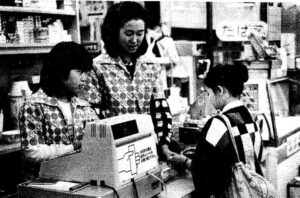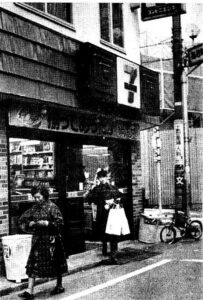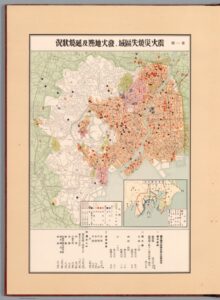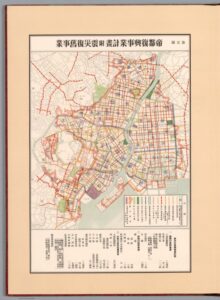While stationed in Yokosuka during the American occupation of Japan, the cartoonist Bill Hume began drawing cartoons featuring a character named “Babysan,” a highly sexualized caricature of Japanese women. Babysan: A Private Look at the Japanese Occupation was published in 1953 and in 1965, Tony Zidek published a similar collection of cartoons called Choi Oi! The Lighter Side of Vietnam, while serving in the Vietnam war. Published as “morale-building” material for deployed soldiers as well as nostalgic accounts for those who had returned to the US, the books depict the interactions of American soldiers with Japanese and Vietnamese women. Looking beyond their overt objectification of women, they provide insight into the roles these women played in the economic systems which developed under the American presence.
The women depicted in Babysan belong to “the greyer category of what were sometimes referred to as onrii (from ‘only’ or ‘only one’), or women who engaged in serial, ostensibly monogamous relationships with ‘only one’ uniformed lover at a time, and who received various forms of material compensation in return.”1 Although Japanese women are portrayed primarily as objects of American consumption, the cartoons suggest that women held considerable power over financial transactions. One cartoon features Babysan remarking, “No dependent?” as she looks over her boyfriend’s tax form.2 Hume describes how the boyfriend is not only expected to support Babysan financially, but in some cases her family as well. Women are depicted as being dependent upon the support of American soldiers, but also as financially intelligent and using their “resources” (American soldiers) as effectively as possible. Hume states that, “Japanese women are traditionally the holders of the purse strings, so Babysan knows of many more practical ways of using his okane.”3 Not only do women control the “purse strings” of American soldiers, but Hume suggests that many women had multiple American partners and therefore multiple sources of income.
To ensure their financial security, women relied on networks of information to learn the whereabouts of their partners. In Babysan, Hume describes how “She and her girl friends, with apparently the help of everyone else in town, have a highly efficient communication system that the Americans call the grapevine,” a system which “gives them a forecast of their economic future.”4 Although Babysan makes no direct references to black markets or prostitution, they were highly successful around American bases and likely relied on similar systems of communication. Around 70,000 women were employed legally as prostitutes and thousands more worked on a private basis.5 Each of these ventures relied on the capital provided by Americans, combined with an internal network of information.
Like Japan, Vietnam saw the rise of black market operations following an influx of American soldiers. “American goods dominated storefronts and street vendors’ stands in Saigon, Hue and Da Nang, putting a tight pinch on local manufacturing which could not compete. American soldiers and civilians, and the United States government, had money to spend… Vietnam realised with equal cleverness that there was money to be made.”6 As black markets flourished in Vietnam, so did currency fraud which was facilitated by informal street vending stalls or “Howard Johnsons.” One cartoon from Choi Oi remarks, “Saigon’s ‘Howard Johnsons’ do have a flair for providing ‘extra’ services also. Numbered among them is the illegal exchange of money.”7 Another cartoon depicts a Howard Johnson advertising the daily exchange rate of piastres to dollars and an exchange between the woman running the stall and an American soldier.8
Vietnamese, particularly women, often played the role of go-between in these schemes. For example, a soldier might get wind of an upcoming MPC conversion date… A soldier would take X piastres to the US exchange at a particular installation and purchase US dollars. He (or his Vietnamese house servant or girlfriend) would then take the dollars to the black market and purchase X + Y piastres, Y being the difference between the rate at the American exchange and the black market rate of exchange.9
Women were both “go-betweens” for Americans as well as the ones exchanging money and operating stalls. Their role extended beyond that of wife or girlfriend, and even beyond the Vietnam War itself. After socialist forces took and renamed Saigon, “In Ho Chi Minh city women from the middle and upper classes were involved more in socio economic activity, they were also more active in business and financial transactions, and in the black market.”10 Even after the American presence in Vietnam disappeared, women continued to play important roles in the economic systems that had taken hold as a result of the war.
While the women in Babysan and Choi Oi appear as sexualized objects of humor and entertainment, the cartoons suggest that their real role in post-war and wartime economies was varied and complex. The American presence in Japan and Vietnam was a major contributing factor to the economic hardship faced by Japanese and Vietnamese women, but while American soldiers were present, women used soldiers both as a source of income and as a way to make the most of the financial situation caused by their presence.
- Kim Brandt, “Learning from Babysan,” review of Babysan, by Bill Hume, Japan Society, 3 https://aboutjapan.japansociety.org/learning-from-babysan#sthash.pt5iJI39.dpbs. [↩]
- Bill Hume, Babysan: A Private Look at the Japanese Occupation (Tokyo: Kasuga Bocki K.K., 1953), 56-57. [↩]
- Hume, Babysan, 92. [↩]
- Ibid., 98. [↩]
- Brandt, “Learning from Babysan,” 2, 9. [↩]
- William Allison, “War for Sale: The Black Market, Currency Manipulation and Corruption in the American War in Vietnam,” in War & Society 21 no. 2, (2003): 135. [↩]
- Tony Zidek, Choi Oi! The Lighter Side of Vietnam (Rutland & Tokyo: Charles E. Tuttle Co., 1965), 34. [↩]
- Zidek, Choi Oi!, 35. [↩]
- Allison, “War for Sale,” 146. [↩]
- Tran Phi Phuong, “Work and family roles of women in Ho Chi Minh City,” in International Education Journal 8 no. 2, (2007): 290. [↩]




